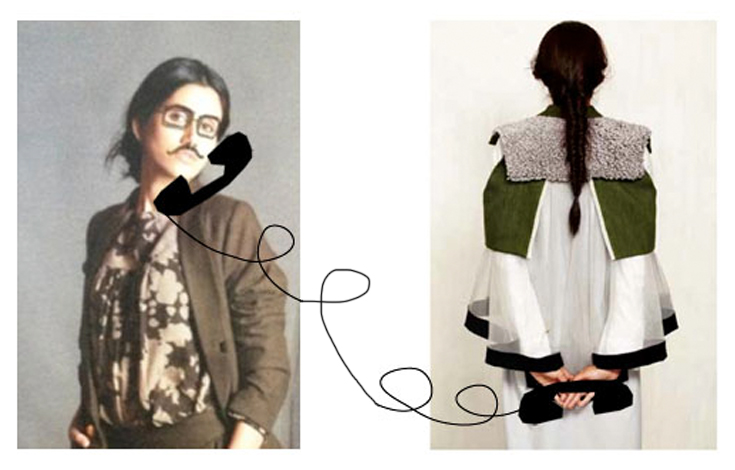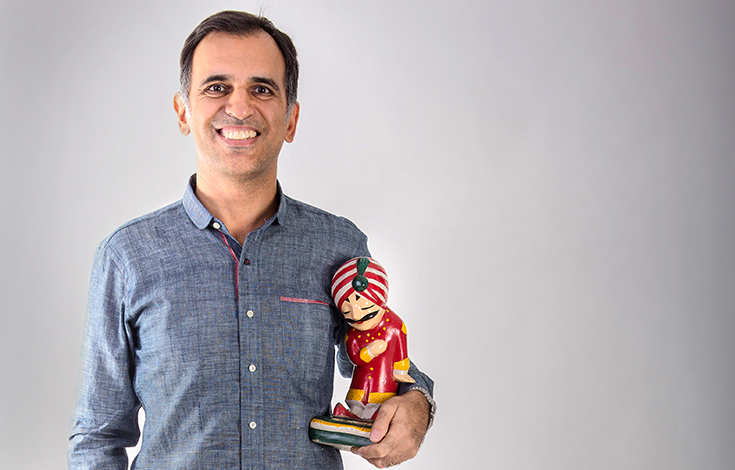In my own anthropological work that has focused on analyzing production practices of fashion in India over the last year, I have found myself asking diverse questions of the industry: who has the right to claim ownership of an aesthetic idea? How do we simultaneously embrace technological changes in garment production and keep our ‘traditions’ alive? And perhaps most importantly (but least addressed), who is responsible for imagining the categories of tradition and technology, craftsman and modern fashion?
The platform of fashion education is one forum in which the answers to these questions appear to neatly coalesce. As thousands of keen fashion students in India step into an already established, globally expanding fashion empire pressures and promises are equally intense. How to navigate these multiple forces often comes down to supposedly concrete, quantifiable ideas of what they are responsible for personally and how responsible they are as individuals. These measures, if met by some subjective means (as they are by ‘good students’) are presented as adequate to negotiate any challenge – philosophical or technical – that may arise through a fashion design career. However, using my observations at The National Institute of Fashion Technology in Delhi, where I conducted fieldwork from July-December 2012, I found the relationship between fashion education and its various covenants to be address in both expected and surprising ways.
There is no question that the space of the Fashion Institution harnesses a commitment to responsibility. However, while ‘responsibility’ is often presented as fixed and transferrable through pedantic means, I suggest that the multiple ways in which students and professors navigate this idea both inside and outside the classroom indicates the complexity of this relationship. By exploring the relationship between definition and experience below, I use personal narratives and observations to show how these paradoxically operate both in tandem with and unlike institutional truths.
cov·e·nant
1. Law: formal sealed agreement or contract.
To think about the relationship between a covenant (in a legal sense) and fashion which is always associated with liberty seems contradictory. However, the ways in which certain standards for clothing production become implicit laws in a fashion classroom suggest that liberty and the production of clothing are far from synonymous. One could easily argue that certain ‘laws’ are laid down for fashion students, and these come to light most clearly in the exploration of a creative process. When students are encouraged to freely make garments, they encounter laws that are more often couched in the language or ‘rules.’
In the name of teaching students the most important lesson in fashion – how to make a garment with good ‘fit ‘ – professors would reinforce subjective truths such as where a short dress should end and thus, where a law begins.
Have you ever seen a skirt that ends at this length? A professor could use a rhetorical strategy to point out to a student that he or she was heading towards failed production. Or have you ever seen a skirt with so much ease near the border? Have you ever seen a trapeze silhouette made like this?
In my notes, I have an endless list of these kinds of questions (where the answer was always NO) that professors would pose to their students in the Design Process Class – a fundamental, core class for any Fashion Design student. In the name of teaching students the most important lesson in fashion – how to make a garment with good ‘fit ‘ – professors would reinforce subjective truths such as where a short dress should end and thus, where a law begins. These kinds of teachings revealed how things that seem subjective could through constant re-enforcement be viewed not only as correct but also as necessarily and historically true.
These implicit rules were for some students, important points of contestation. ‘Why can’t I make these pants with three zips’ or ‘why can’t I make a dress with a sleeve here’ however, were soft retorts that would always get refuted when the grade book register was presented as final judge. The students ‘pass’ would be determined according to how well the rules were followed but the contestations would continue in the form of a healthy dialogue outside of the classroom. These conversations would often articulate differences about what the imagined consumer in India looks like today. “If we could all make clothes for Lady Gaga, we’d be in business,” a pattern design teacher once responded to a student who explicitly broke a dress form rule. “But ma’am, I want to make clothes for her,” the student responded as she packed her bags for lunch break.
“If we could all make clothes for Lady Gaga, we’d be in business,” a pattern design teacher once responded to a student who explicitly broke a dress form rule. “But ma’am, I want to make clothes for her,” the student responded
cov·e·nant 2.
In the Bible, God’s promise to the human race.
Covenants as promises are difficult to keep but regularly made. Most of all, the promise of success — the covenant that a good education will lead to a good job –is what drives and sustains many fashion institutions, and NIFT is no exception.
The promise of success at NIFT is in theory, dependent on hard work and the more subjective factor of talent. These two magical ingredients were noted as fundamental to success across all the interviews I conducted with professors during my fieldwork at the university. Students were constantly promised and assured success if they had not one, but both of these ingredients.
However, in my interviews with students, they added a complex aspect to what seemed to be this fundamental list of ingredients. Many of them would cite examples of people who had built their careers through not talent and hard work, but connections. Connections were not promised, lay outside the realm of the institution, and were largely linked to success. So, rumors about which famous designer was which famous designer’s boyfriend were numerous.
“Who you know, and what you are and who that will allow you to talk to” is how one student described the logic of connections as they work in the Indian fashion space. In addition he added, “professors should make us aware that this is also important – it’s not just about hard work.”
Our discussion evolved to touch upon why connections – which operate as loose, subjective things but are grounded in class relations – would interfere with the apparent objectivity of teaching responsibility through education.
However, this does not lead to the conclusion that then, fashion education is some sort of mainstream educational choice that saps the creativity out of students. Rather, students, as responses to institutional rules develop creativity and alternative forms of being.
cov·e·nant 3.
A binding agreement; a compact.
A covenant as a binding agreement in educational institutions most often invokes the voice of authority for students and the means to power for professors. I imagine that covenants of an obligatory kind at NIFT work in the way they do across any formal educational institution. Attendance sheets are the ultimate symbol of a successful covenant. A good record indicates progress, missing class ruptures a covenant. Professors painstakingly maintain attendance records on a daily basis. In theory and by the word of a covenant, an absence is an absence. If you (or your clever friend) can respond ‘yes ma’am’ to your name when roll is called, you’re good.
However, when attendance is not met and the covenant is breached on paper, other non-bureaucratic forms of covenants are born:
I noticed that a young girl who was a joyous presence in a Surface Design Techniques class went missing for days on end. Every time her name was called on the roster, another friend of hers would pipe up to explain that she was not well. It was clear that the student had a tight kin network and her illness was a shared responsibility amongst her peers.
When she did show up after a long gap, I noticed her mouth was swollen and a few bulky gauze bandages soaked in blood had been placed as a barrier between her tongue and teeth. When her name was called for attendance on this day that she was present, she simply stood up and pointed to her mouth. The professor rushed over to her, gave her a tight hug and proceeded to console her. A detailed history of her accident and follow up treatments was recounted in front of a large part of the class.
Good students are not necessarily remembered for being avant-garde risk takers but for being technically competent and fit for an internship or export-industry job at the point of graduation.
The consolation did not end there. As I followed the students to the end of the semester, I found that the relationship between her and teacher, NIFT and student expanded to include the state of her emotional well- being as well as her academic progress. There were numerous times I heard her mentors offer her remedies and look in to her mouth with whatever wisdom they could offer while simultaneously grading her on an assignment.
In this case, the most binding form of a covenant – registered attendance – induced another kind of bind and bond between authority and scholar. Moreover, the idea of responsibility as rigid, oppressive and neatly documented was challenged by the kind of care the student received from the institution.
Conclusion
My work at NIFT has been key in destabilizing the notion that fashion – especially in the form of fashion education – operates within a set of rules. However, looking at how this destabilization is produced is not entirely predictable. While it is a cliché that fashion is about taking risks and going against the grain, I found that the institution works over time in assuring students that it is not. Learning how to ‘really’ make patterns and de-glamorizing the profession of the fashion designer is seen as part and parcel of the professors’ job. Good students are not necessarily remembered for being avant-garde risk takers but for being technically competent and fit for an internship or export-industry job at the point of graduation.
However, this does not lead to the conclusion that then, fashion education is some sort of mainstream educational choice that saps the creativity out of students. Rather, students, as responses to institutional rules develop creativity and alternative forms of being. The ‘truths’ and ‘rules’ of becoming a designer and working in the industry are in other words, not static end-points for students. They are presented as responsibilities and by people who are perceived as responsible, but responsibilities themselves, are interpreted in variable ways.
_________________
Meher Varma is a cultural anthropologist. She lives in New Delhi and is currently working on her PhD dissertation focused on issues in Indian fashion design.





Your article is insightful and well written. However, you miss mentioning that in order to succeed as designers that ‘take risks and go against the grain’, it is essential that students of fashion first learn what constitutes the grain in the first place.
(Here I make the assumption, based on the subjects you mention, that your study involved undergraduate students).
To give a simplistic example, Picasso did not start drawing two eyes on the same side of a face without a thorough understanding of how to accurately represent a human face using proportion, scale and the time-tested rules of realistic portraiture.
It is only after mastering what are often called basic skills that most creative people develop a style of their own, and some – a fortunate and ‘talented’ few are able to go a step further and take those very risks by rewriting the rules in such a fundamental way that a new aesthetic is born.
So when teachers of fashion design in your opinion break ‘the cliché that fashion is about taking risks and going against the grain,’ by assuring students that it is not – they do so because in this early stage of learning the ropes – in fact it is not.
Attendance to classes too seems to emphasize that cheesy quote from Woody Allen that 90% of life involves just showing up. But then guess what – it’s true. A lesson learnt the hard way stays with you. Lee Kwan Yew would defend Singapore’s oft-ridiculed law of banning chewing gum by insisting that ingrained Asian habits of spitting cannot be removed by gentler means. Generations of Singaporeans now have it in their blood that spitting and littering will not be tolerated. So much so that even abroad, they do not spit and their public spaces are the cleanest in Asia.
However I do agree that in many circumstances, students more often than not find interesting ways to individuality despite the oft maligned Rules that are imposed upon them. And it is in these little crevices between The Rules that little sparks of creativity find their expression.
Until the day the hapless student, bright eyed and relieved of institutional shackles – finds that dream fashion job – and realises that in fact those very Rules – well learnt and diligently applied – are what will stand him or her in good stead until the day dawns when they find their own unique individual expression that enables them to take those risky risks and go against that ingrained grain.
Fashion is not a simple theme and there is still a great level of uncertainty regarding the way of teaching this subject. Indeed many schools around the world are still looking for the optimal way of running these kinds of courses.
Teachers can only do their best to share their knowledge and most of all students should be curious and always searching for new ways of expressing themselves.